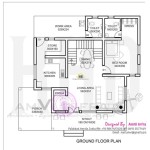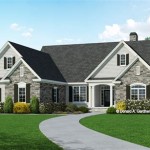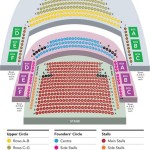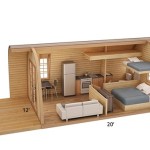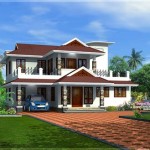Floor Plans for Small Guest Houses: Maximizing Space and Functionality
The demand for guest houses, often referred to as accessory dwelling units (ADUs) or granny flats, has increased significantly in recent years. These structures provide homeowners with versatile spaces for visiting friends and family, rental income opportunities, or even a comfortable living space for aging parents. Successfully designing a small guest house hinges on thoughtful floor plans that optimize space, functionality, and comfort within a limited footprint. This article explores key considerations and design strategies for creating efficient and appealing floor plans for small guest houses.
Understanding Spatial Constraints and Priorities
Before diving into specific floor plans, it’s crucial to understand the limitations imposed by the small size of the guest house. Every square foot counts, demanding careful prioritization of essential elements. Common space constraints often manifest as limited dimensions for living areas, compact kitchens, and smaller bathrooms. Therefore, determining the core purpose of the guest house strongly influences the layout and design decisions.
If the primary function is short-term guest accommodation, the emphasis might be on a comfortable sleeping area, a functional bathroom, and a small kitchenette for basic meal preparation. Conversely, if the guest house is intended for longer-term occupancy, a more comprehensive kitchen, adequate storage space, and a dedicated living area will become more important. Furthermore, accessibility considerations, for example, ramps or wider doorways, are paramount if the guest house is designed for elderly or disabled individuals. Identifying and prioritizing these needs at the outset is fundamental in developing an efficient floor plan.
Local zoning regulations and building codes also play a substantial role. Setback requirements, height restrictions, and minimum square footage regulations can significantly impact the available building envelope. Thoroughly researching and understanding these restrictions is an essential first step to prevent design complications and costly revisions later in the project.
Optimizing Space Through Design Strategies
Several design strategies can be employed to maximize usable space in a small guest house. The open-concept layout is a popular approach, merging the living, dining, and kitchen areas into a single, flowing space. This eliminates the need for dividing walls, creating a more spacious and airy feel. Strategic furniture placement can further define these areas within the open layout. For instance, a strategically positioned sofa can delineate the living area from the dining space, while a kitchen island can serve as a breakfast bar and a visual barrier between the kitchen and living areas.
Vertical space utilization is another key strategy. Incorporating built-in storage, such as shelves that extend to the ceiling, maximizes storage capacity without consuming valuable floor space. Loft beds, which free up floor space below for a desk or seating area, are also a viable option, particularly in guest houses with higher ceilings. Multifunctional furniture, such as sofa beds or ottomans with storage, provides dual functionality and saves space. Choosing furniture with a smaller footprint is also crucial. Opting for compact appliances, such as a smaller refrigerator and a cooktop instead of a full-sized oven, can free up valuable kitchen space.
Strategic window placement can significantly impact the perceived spaciousness of a small guest house. Larger windows and skylights allow ample natural light to flood the interior, creating a brighter and more inviting atmosphere. Positioning windows to capture views of the surrounding landscape can also contribute to a sense of openness and connection to the outdoors. Furthermore, carefully considering the window treatments is important. Light-filtering shades or blinds allow natural light to enter while providing privacy.
The use of color and lighting can also contribute to the perception of spaciousness. Lighter colors reflect more light, making the space feel larger and brighter. Minimizing clutter and maintaining a clean and organized environment is essential in making the most of limited space. Adequate artificial lighting is also crucial. Recessed lighting, track lighting, and wall-mounted sconces can provide ample illumination without taking up floor space.
Sample Floor Plan Configurations and Considerations
Numerous floor plan configurations can be adapted to a small guest house, each with its own advantages and disadvantages. A studio layout, which combines the living, sleeping, and kitchen areas into a single room, is a common option for very small spaces. In a studio layout, careful space planning is essential to ensure that each area is functional and well-defined.
A one-bedroom layout offers more privacy and separation of space. This typically includes a separate bedroom, a living area, a kitchen, and a bathroom. The layout can be configured in various ways, depending on the available space and the desired flow. For example, the bedroom can be located at the rear of the guest house, offering privacy and quiet, while the living area and kitchen are located at the front. Alternatively, the bedroom can be positioned to one side of the guest house, with the living area and kitchen occupying the other side.
A split-level layout, where the guest house is divided into two levels, can be an effective way to maximize space, particularly on sloped lots. This can create discrete living and sleeping areas, with the bedroom located on one level and the living area and kitchen on the other. However, split-level layouts can be more complex and costly to construct.
When designing the bathroom, consider incorporating a shower instead of a bathtub to save space. A wall-mounted sink and a toilet with a concealed tank can also help to maximize space. In the kitchen, consider using a combination microwave and convection oven to save space and reduce the need for separate appliances. Open shelving can provide storage without making the kitchen feel cramped.
The placement of the entrance door is also a crucial consideration. Placing the entrance door on the side of the guest house, rather than the front, can create a more private and secluded entrance. A small porch or patio can provide an outdoor seating area and enhance the overall appeal of the guest house.
The exterior design should complement the existing architecture of the main house. Using similar materials and colors can create a cohesive and harmonious look. Landscaping can also play a role in enhancing the appearance of the guest house. Planting trees and shrubs can provide privacy and create a more inviting atmosphere.
Ultimately, the best floor plan for a small guest house will depend on the specific needs and preferences of the homeowner and the intended use of the space. Careful planning and attention to detail are essential in creating a functional, comfortable, and aesthetically pleasing guest house.
Integrating Essential Amenities and Functionality
Beyond the basic layout, integrating essential amenities and functionalities is crucial for creating a livable and enjoyable guest house. Adequate storage is often overlooked in small spaces but is essential for maintaining a clutter-free environment. Built-in closets, drawers under the bed, and wall-mounted shelves can help to maximize storage capacity without taking up valuable floor space. A small laundry area, even just a stacked washer and dryer, can be a valuable addition, especially for longer-term guests.
Proper insulation and ventilation are vital for maintaining comfortable temperatures and preventing moisture buildup. Adequate insulation in the walls, roof, and floor will help to reduce energy consumption and lower utility bills. A well-designed ventilation system will help to circulate fresh air and prevent mold and mildew growth. Consider installing a small air conditioning unit or a ceiling fan for added comfort during hot weather.
Sufficient electrical outlets and lighting are essential for convenience and safety. Place outlets in strategic locations throughout the guest house, including near the bed, desk, and kitchen counter. A combination of ambient, task, and accent lighting can create a warm and inviting atmosphere. Consider installing dimmers to control the brightness of the lights and save energy.
Ensuring adequate soundproofing is important, particularly if the guest house is located close to the main house or a busy street. Insulating the walls and ceiling with soundproofing materials can help to reduce noise transmission. Installing solid-core doors can also help to minimize noise. Consider adding weatherstripping around doors and windows to prevent drafts and reduce noise.
Thoughtful landscaping can enhance the functionality and privacy of the guest house. Planting trees and shrubs can provide shade and create a visual barrier between the guest house and the main house. A small patio or deck can provide an outdoor seating area and extend the living space. Consider installing a privacy fence or screen to create a more secluded outdoor area.

Plan 73931 Detached Guest House Or Tiny With Photos

Hatchet Creek Cabin Small Guest House Plan

Gorgeous Guest House Floor Plans Interior Design Ideas Alisha Taylor

Guesthouse Plans For A Small 2 Bedroom Lakeside Cabin

Plan 69638am One Bedroom Guest House

Gorgeous Guest House Floor Plans Interior Design Ideas Alisha Taylor

Historic Shed Cottage Tiny House Blog

Ivon Guest House Coastal Plans From Home

Truoba Mini 615 Modern House Plan 924 3

2 Story Guest House Plans 1000 Sq Ft 3 Bed Bath Design


